
- Folk Art Carved
- Culture
- African (26)
- American (19)
- American South (4)
- Americana (4)
- Appalachian (3)
- Balinese (20)
- Folk Art (25)
- Guatemalan (6)
- Haitian (3)
- Indonesian (18)
- Mexican (289)
- Native American: Us (9)
- Native Hawaiians (3)
- Navajo (4)
- Pennsylvania Dutch (30)
- Peruvian (4)
- Puerto Rican (4)
- Unknown (11)
- Western (6)
- Western Americana (5)
- Other (3258)
- Format
- Bust (18)
- Cameo (2)
- Carved Wood (4)
- Carving (21)
- Diarama (2)
- Figurine (3)
- Full Body (3)
- Full Body Carving (5)
- Hand Carving (2)
- Light Sculpture (22)
- Mask (18)
- Mobile (3)
- Primitive (2)
- Sculpture (7)
- Shield (6)
- Statue (294)
- Wall Art (8)
- Wall Hanging (4)
- Wall Sculpture (8)
- Wood Sculpture (11)
- Other (3308)
- Size
- Style
- 3d, Cartoon (10)
- African (10)
- American (41)
- Americana (165)
- Americana, Folk Art (10)
- Antique (15)
- Asian (11)
- Black Folk Art (33)
- Black Forest (24)
- Cane (24)
- Country (28)
- Folk Art (952)
- Naive, Primitive (95)
- Primitive (14)
- Rustic (11)
- Rustic / Primitive (26)
- Tramp (17)
- Tramp Art (22)
- Vintage (22)
- Walking Stick (45)
- Other (2176)
- Type
- Unit Of Sale
Amazing RARE Antique 19th c. American Folk Art Wood Whirligig Sculpture, WOW
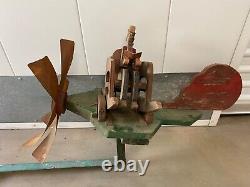
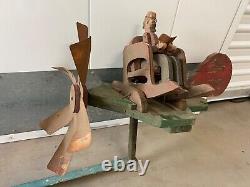
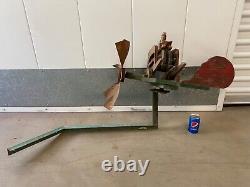
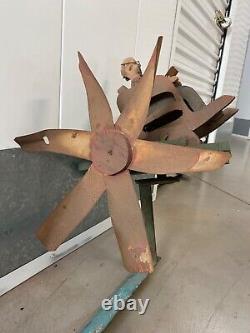
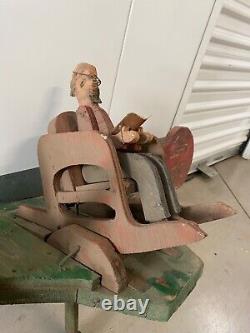
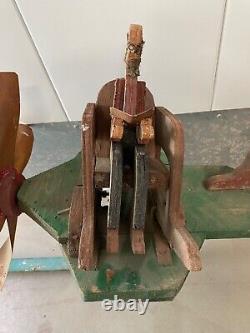
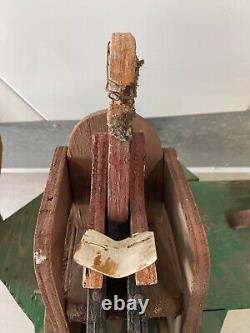
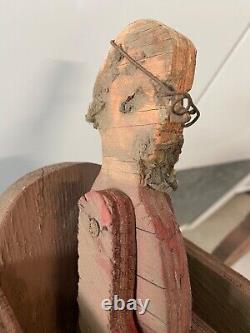
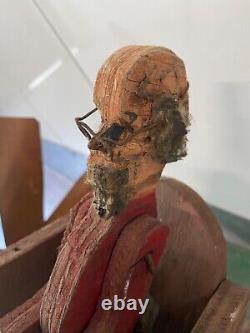
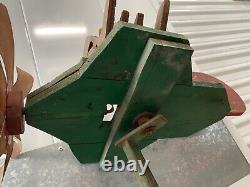
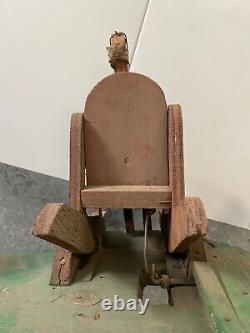
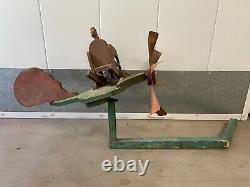


This is a very intricate, whimsical and Amazing RARE Antique 19th c. American Folk Art Wood Whirligig Sculpture, depicting an old man or grandfather in a rocking chair, holding a book in his lap.
The figure wears tiny hand-made metal spectacles and has remnants of wool on his head and chin, which served as his hair and beard. This whirligig is completely functional, and a mechanism behind the rocking chair makes the figure rock to-and-fro when the tin pinwheel on the end is spinning. This piece likely dates to the 1890's - 1910's based on the nails used and the construction of the piece, and probably originated from the American Northeast.
This artwork has a good honest original patina, with oxidation, wood splitting, minor paint loss, scuffing, etc. This is the real deal and not some cute replica from Etsy! Approximately 48 inches long (including metal post) x 24 inches tall x 20 inches deep. Therefore, the S&H cost will be quite high. The subject depicted, a reading old man and in his rocking chair, is very uncommon and I have not seen another like it anywhere. This would easily be a featured piece on Antique Roadshow. Please check out my other listings for more wonderful and unique artworks! Treasures: Experts take a spin at value of whirligig. According to the famous real-estate cliché, it's location, location, location. " But in the antiques world, the byword is "condition, condition, condition. " For those who do not know and may think that a "whirligig is some sort of child's toy, it is actually an object that spins, turns or has at least one moving part to indicate wind direction - much like a weather vane. A whirligig is also known as a buzzer, a comic weather vane, a gee-haw or a spinner. Whirligigs are normally driven by the wind, but they may also be hand- or friction-powered, or even powered by a motor.There are plenty of examples of weather vanes in ancient civilizations, but the first known visual representation of a European whirligig can be found in a medieval tapestry that depicts children playing with one. Later, paintings by Hieronymus Bosch and Jan Provost also represented the curiosity in oil. The piece in today's question is clearly much more contemporary than those. Whirligigs became somewhat fashionable in this country's Appalachian region during the mid- to late-19th century, and their popularity expanded to other regions at the turn of the 20th century.
These colorful, animated devices added an element of fun to an otherwise demanding life in rural America and have become a well-established subcategory in the field of folk art. Older ones with interesting, novel and clever designs have increased in value.
Today, whirligigs are used as mechanisms in gardens to frighten birds and as novelty items, decorative outdoor art and children's toys. Craftsmen still make them, but unfortunately, most of the new ones on the current market are stamped and painted metal that is mass-produced in China. This item is in the category "Antiques\Primitives". The seller is "willsusa_utzeqm" and is located in this country: US.This item can be shipped to United States.
- Region of Origin: US-Northeast
- Size Type/Largest Dimension: Large (Greater than 30in. )
- Style: Naive, Primitive
- Maker: Unknown
- Material: Wood
- Original/Reproduction: Original
- Date of Creation: 1800-1899
- Category: Antiques
- Featured Refinements: Antique Folk Art
- Type: Sculptures & Carvings
- Signed: Unsigned

